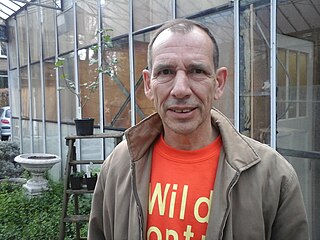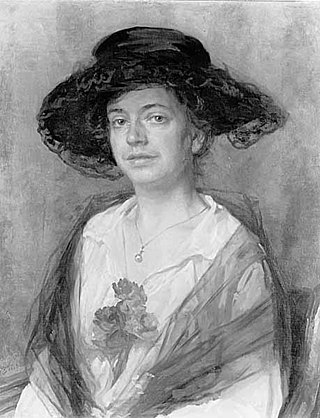
The Rijksmuseum is the national museum of the Netherlands dedicated to Dutch arts and history and is located in Amsterdam. The museum is located at the Museum Square in the borough of Amsterdam South, close to the Van Gogh Museum, the Stedelijk Museum Amsterdam, and the Concertgebouw.

The Hague is the capital city of the South Holland province of the Netherlands. With a population of over half a million, it is the third-largest city in the Netherlands. Situated on the west coast facing the North Sea, The Hague is the country's administrative centre and its seat of government, and while the official capital of the Netherlands is Amsterdam, The Hague has been described as the country's de facto capital since the time of the Dutch Republic.

The Mauritshuis is an art museum in The Hague, Netherlands. The museum houses the Royal Cabinet of Paintings which consists of 854 objects, mostly Dutch Golden Age paintings. The collection contains works by Johannes Vermeer, Rembrandt van Rijn, Jan Steen, Paulus Potter, Frans Hals, Jacob van Ruisdael, Hans Holbein the Younger, and others. Originally, the 17th-century building was the residence of Count John Maurice of Nassau. The building is now the property of the government of the Netherlands and is listed in the top 100 Dutch heritage sites.

The Hague School is a group of artists who lived and worked in The Hague between 1860 and 1890. Their work was heavily influenced by the realist painters of the French Barbizon school. The painters of the Hague school generally made use of relatively somber colors, which is why the Hague School is sometimes called the Gray School.

The Kunstmuseum Den Haag is an art museum in The Hague in the Netherlands, founded in 1866 as the Museum voor Moderne Kunst. Later, until 1998, it was known as Haags Gemeentemuseum, and until the end of September 2019 as Gemeentemuseum Den Haag. It has a collection of around 165,000 works, over many different forms of art. In particular, the Kunstmuseum is renowned for its large Mondrian collection, the largest in the world. Mondrian's last work, Victory Boogie-Woogie, is on display at the museum.
The Museum Card, also known as the Museumkaart in Dutch, is a personal card that grants free entry to approximately 400 museums in the Netherlands for one year. It is available for purchase at many of the larger participating museums or online, with a temporary card issued when purchased from the museum. While most museums offer free entry to Museum Card holders, some museums may charge an additional fee for special exhibitions, but not for general collections.
The Miniature Museum of Modern and Contemporary Art was founded by Ria and Lex Daniels in 1990. It was initially located at the AMC hospital in Amsterdam, but moved to the Kunstmuseum Den Haag in 2013, where it was on a long-term loan for five years.

Andreas Schelfhout (1787–1870) was a Dutch painter, etcher and lithographer, known for his landscape paintings.
Jean Humbert de Superville was a Dutch painter of Swiss and French extraction. Humbert was primarily known as a portrait painter.

The Hofvijver is a small lake in the centre of The Hague, Netherlands. It is adjoined in the east by the Korte Vijverberg road, in the south by the Binnenhof and the Mauritshuis, in the west by the Buitenhof and in the north by the Lange Vijverberg road. In the middle there is an islet with plants and trees which has no name; it is usually referred to as "the island in the Vijverberg".

Lange Voorhout Palace in The Hague was designed in 1760 by the architect Pieter de Swart for Anthony Patras (1718-1764), a deputy to the States General of the Netherlands.

August Allebé was an artist and teacher from the Northern Netherlands. His early paintings were in a romantic style, but in his later work he was an exponent of realism and impressionism. He was a major initiator and promoter of Amsterdam Impressionism, the artist's association St. Lucas, and the movement of the Amsterdamse Joffers. Amsterdam Impressionism – sometimes referred to by art historians as the School of Allebé – was the counterflow to the very strong Hague School in the movement of Dutch Impressionism. As a professor at the Royal Academy of Amsterdam he fostered a cosmopolitan attitude toward art and the promotion and motivation of his students, and provided a significant stimulus to developments in modern art.

The Gevangenpoort is a former gate and medieval prison on the Buitenhof in The Hague, Netherlands. It is situated next to the 18th-century art gallery founded by William V, Prince of Orange in 1774 known as the Prince William V Gallery.
The following is a timeline of the history of the municipality of The Hague, Netherlands,

KM21 is a museum for contemporary visual art in The Hague in the Netherlands. The museum was established in 2002 as part of the Kunstmuseum Den Haag. In KM21 work by artists from The Hague, the Netherlands and international contemporaries is exhibited.

Bernardus Stefanus Henricus (Ben) Zegers is a Dutch visual artist, active as a sculptor and installation artist, and teacher and coordinator at the Gerrit Rietveld Academy.

Willemine Elisabeth Edzardine (Lita) de Ranitz was a Dutch art collector. Her collection of dollhouses and related items is now in the Historical Museum of the Hague.
Gerardina Anna Allegonda Martina Hooft (1894-1994) was a Dutch painter known for her still lifes.

The Fotomuseum Den Haag is a photography museum in The Hague. The museum was founded in 2002. It was a spin-off of the nearby Kunstmuseum Den Haag, when then director Wim van Krimpen decided that the Kunstmuseum's collection of photography had become so rich that it deserved a separate location. It shares an entrance and space with the museum of contemporary art KM21.














